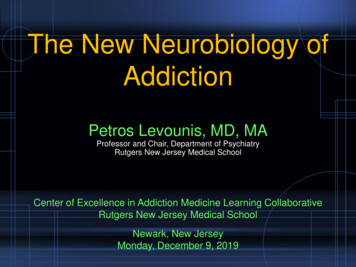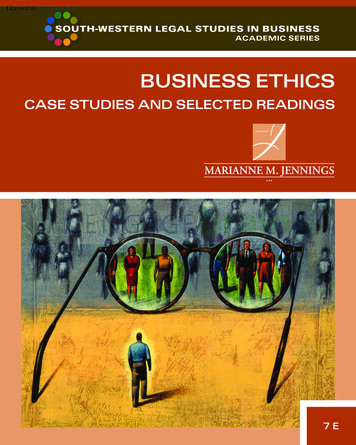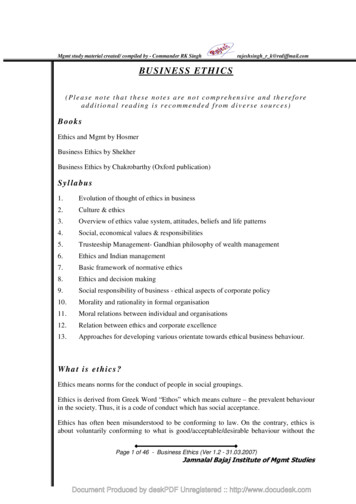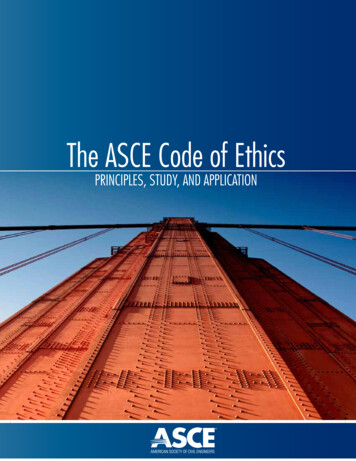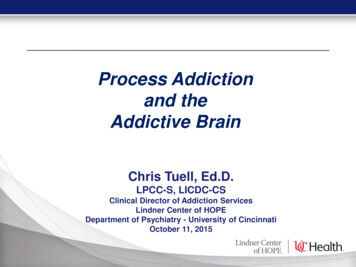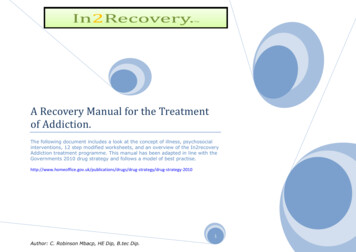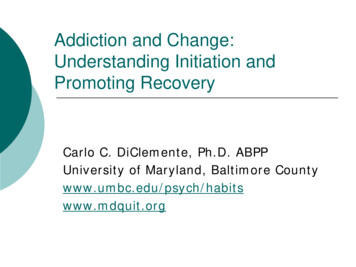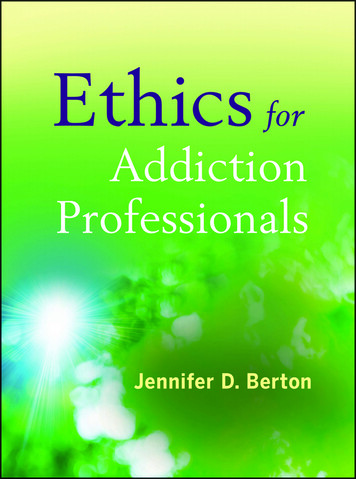
Transcription
Ethics forAddictionProfessionals
ETHICS FORADDICTIONPROFESSIONALSFrom Principle to PracticeJennifer D. Berton
Cover Design: Andrew LieferCover Images: imagewerks/Getty ImagesThis book is printed on acid-free paper.Copyright 2014 by John Wiley & Sons, Inc. All rights reserved.Published by John Wiley & Sons, Inc., Hoboken, New Jersey.Published simultaneously in Canada.No part of this publication may be reproduced, stored in a retrieval system, or transmitted in any form or by anymeans, electronic, mechanical, photocopying, recording, scanning, or otherwise, except as permitted under Section107 or 108 of the 1976 United States Copyright Act, without either the prior written permission of the Publisher, orauthorization through payment of the appropriate per-copy fee to the Copyright Clearance Center, Inc., 222Rosewood Drive, Danvers, MA 01923, (978) 750-8400, fax (978) 646-8600, or on the web at www.copyright.com.Requests to the Publisher for permission should be addressed to the Permissions Department, John Wiley & Sons,Inc., 111 River Street, Hoboken, NJ 07030, (201) 748-6011, fax (201) 748-6008.Limit of Liability/Disclaimer of Warranty: While the publisher and author have used their best efforts in preparingthis book, they make no representations or warranties with respect to the accuracy or completeness of the contentsof this book and specifically disclaim any implied warranties of merchantability or fitness for a particular purpose. Nowarranty may be created or extended by sales representatives or written sales materials. The advice and strategiescontained herein may not be suitable for your situation. You should consult with a professional where appropriate.Neither the publisher nor author shall be liable for any loss of profit or any other commercial damages, including butnot limited to special, incidental, consequential, or other damages.This publication is designed to provide accurate and authoritative information in regard to the subject mattercovered. It is sold with the understanding that the publisher is not engaged in rendering professional services. If legal,accounting, medical, psychological or any other expert assistance is required, the services of a competent professionalperson should be sought.Designations used by companies to distinguish their products are often claimed as trademarks. In all instances whereJohn Wiley & Sons, Inc. is aware of a claim, the product names appear in initial capital or all capital letters. Readers,however, should contact the appropriate companies for more complete information regarding trademarks andregistration.For general information on our other products and services please contact our Customer Care Department within theUnited States at (800) 762-2974, outside the United States at (317) 572-3993 or fax (317) 572-4002.Wiley publishes in a variety of print and electronic formats and by print-on-demand. Some material included withstandard print versions of this book may not be included in e-books or in print-on-demand. If this book refers tomedia such as a CD or DVD that is not included in the version you purchased, you may download this material athttp://booksupport.wiley.com. For more information about Wiley products, visit www.wiley.com.Library of Congress Cataloging-in-Publication Data:Berton, Jennifer D.Ethics for addiction professionals / Jennifer D. Berton.1 online resource.Includes bibliographical references and index.Description based on print version record and CIP data provided by publisher; resource not viewed.ISBN 978-0-470-90719-1 (pbk) – ISBN 978-1-118-41830-7 (ebk) – ISBN 978-1-118-41540-5 (ebk) 1. Alcoholismcounselors–Professional ethics–United States. 2. Drug abuse counselors–Professional ethics–United States. I. ed in the United States of America10 9 8 7 6 5 4 3 2 1
To Peter for providing love, balance, and rarebit.
CONTENTSPrefaceAcknowledgmentsxixviiChapter 1Introduction1PART ONEProtecting the Client7Chapter 2Key: Recognize Your Strengths and Limitations9Chapter 3Principle: Client Welfare15Chapter 4Principle: Cultural Diversity25Chapter 5Principle: The Counseling Relationship39Chapter 6Pitfall: Conflicted Agendas51PART TWOProtecting the Clinical Information59Chapter 7Key: Respect the Tiers of Ethics63Chapter 8Principle: Proper Use of Written Clinical Material69Chapter 9Principle: Proper Use of Spoken Clinical Material83Chapter 10Pitfall: Confused Roles95vii
viiiCONTENTSPERSPECTIVEAre We a Profession?113PART THREEProtecting the Clinician123Chapter 11Key: Seek Continuous Learning125Chapter 12Principle: Responsibility129Chapter 13Principle: Competency143Chapter 14Pitfall: Clinician Burnout155PART FOURProtecting the Community177Chapter 15Key: Make the Rule181Chapter 16Principle: Workplace Standards187Chapter 17Principle: Professional Rapport195Chapter 18Principle: Societal Obligations211Chapter 19Pitfall: Cutting Corners217
CONTENTSixConclusion233Ethics Exam237References241About the Author245Author Index249Subject Index253
sPREFACEThe major problem with ethics—hold on, let me climb up on mysoapbox—okay, listen, the major problem is that it is not taught (Taleff,2010). I realize that sounds wrong when you consider how many ethics trainings each clinician will attend throughout his or her career. Ethics trainings areattended more than trainings on any other topic because it is the only specifictopic that must be included in the recredentialing process every 2 years, andit has been suggested this requirement should increase (Gallagher, 2010). Thismeans that an individual clinician who has been working in the field for 25years will attend a minimum of 42 hours of ethics trainings during that time.Despite the significant requirement, ethics education has used more of the“water-cooler technique” of teaching, discussing ethical principles through vignettes after they have occurred, as a group of workers meet at the water coolerto discuss important agency issues and gossip. The heavy use of vignettes is onlyproblematic when it is the only resource used; vignettes are quite appropriateand helpful when they are used to illustrate a fact, theory, or principle. But inmost ethics education, vignettes are used to discuss appropriate clinical action;the principle is implied with the assumption that the clinician has alreadymastered it. Addiction professionals are supposed to innately understand theethical decision (Taleff, 2010). Ethics, it seems, is the one area of clinicalpractice a new clinician is expected to know before becoming a credentialedclinician.Think about that. Many ethical principles are assumed obvious, as if to behuman means you have a general sense of right and wrong behavior. Theproblem with this thinking is that it isn’t true. If you ask any clinician if havingsex with a client is ethical, I can’t imagine any clinician showing support, yetclinicians have sex with clients every year, and it is among the most violatedethical principle in the helping professions, and the most common complaintagainst addiction counselors (St. Germaine, 1996). And just as cheating isconsidered a symptom of a deeper problem in a marriage, having sex with aclient is an indication of a deeper problem that started long before the sex: ablurring of boundaries and power. Now if I asked every one of those clinicianswho are appalled at the idea of having sex with a client to name a time intheir career when they blurred some boundary with a client, every one of thoseclinicians (if honest) would likely have some story to tell. Thus, even if someonehas a good level of personal morals, this does not necessarily indicate that he orshe will be an ethical clinician, and so it is not enough to expect that someoneinterested in becoming a clinician will have a basic sense of ethical behavior.Ethics must be taught.Because many professionals do not have a college degree (Whitter et al.,2006), or obtained a degree in an unrelated field, a large part of the professionalpopulation does not get a college education related to ethics and therefore mustrely on individual professional trainings to teach basic ethical principles andstandards (Gallagher, 2010). If ethical trainings do not teach ethical principlesand demonstrate how to build an ethical practice, these clinicians may beout in the workforce, giving direct practice to clients, without having learnedxi
xiiPrefacesthe basic ethical tools required of addiction professionals. When we hear of ethical missteps, we maysympathize with the affected clients and blame theclinicians involved, but the clinicians may not havereceived the education and the support they needto prevent these errors.Where you are in your career, reader, will not affect the usefulness of the fun we are about to have.If you are a student just entering the profession, letme just say. . . . Welcome! You are the future promiseof our work, thus we are all breathing a collectiveprofessional sigh of relief that you have made thechoice to study our ways. No matter how greatexisting clinicians are now, the beauty of whatwe do will fade away if not for you. You will findloads of useful information and resources in thisbook that will help you understand and developall of the tools necessary to build the most ethicalpractice. If you are actively taking an ethics classright now that uses this book, look up right nowand beam a smile at your teacher as a thank you fortaking your education seriously—Ha, tricked you!You shouldn’t be reading this book in class, youshould be rapt with attention to whatever greatnuggets of knowledge are zooming your way fromyour teacher. Close this book and listen for now,but come back here after class.If you are a seasoned professional, you maybe thinking, “Oh great, another book about ethics.Ethics is so exciting, I can’t wait to dig in” (can youfeel the sarcasm?). Well unroll your eyes for a second, and let’s think about why that sentiment likelywashed over many of you. Ethics historically hasbeen seen as a dry, boring subject. There are twomain reasons why it is so perceived. First, manytrainings and speakers on the topic have been tedious and unvaried. This is most unfortunate because the topic of ethics contains some of the mostemotional material in our clinical practice. It ismeant to be living, breathing, dynamic, and engaging. Attendees leaving a training should be inhealthy turmoil, not bored into slumber. Trainingsneed not regurgitate the code of ethics but bringit to life in clinical example (Gallagher, 2010), yetthe principles of the code should be included intrainings. In the past, the variety of available ethicstrainings typically didn’t meet the need for ongoing continuing education requirements, resulting inthe majority of clinicians attending the same ethicstrainings year after year. This only contributes to thefeeling of tediousness, and leads to the second reason ethics trainings are ill-perceived: that cliniciansfeel the training is unnecessary.Many clinicians feel they have learned the ethical tools they need and are resentful of the ongoingrequirement for additional ethics training. I can’ttell you how many times I’ve heard clinicians sighwith annoyance that they have to go to ethics trainings every 2 years, especially the well-seasonedclinician. “Ugh,” they whine, “I’ve been a clinicianforever. I’ve pretty much seen it all. I would hope bynow I know how to act ethically.” Perhaps you havehad similar thoughts at some point in your career.But if this statement were true, then statistically onewould see a decrease in ethical violations by career length, yet my experience with investigatingethical violations showed no indication that ethicalviolations are more likely to occur in the beginningof one’s career. In fact, the research shows thoseclinicians with less formal education were found tobe more sensitive to ethical dilemmas (Gallagher,2010). Thus, ethics should be taught.Seasoned clinicians may be less sensitive to ethical dilemmas because they become complacent intheir ways. Consider driving a car: New drivers domake errors, but they are also more likely to drive“by the book,” since they just learned the book.Seasoned drivers make all sorts of mistakes according to driver’s education instruction. (How manyof you really put your hands on the wheel at the10 o’clock and 2 o’clock position all the time?)You don’t worry, because you feel your experiencemakes you a safe driver even if you aren’t drivingperfectly. Similarly, seasoned clinicians may commitsmall violations believing them to be innocuous andmay feel satisfied that generally they are skilled professionals who do a heap of good in the lives of theclients they serve.
PrefacesYet small violations can easily turn into biggerviolations, often with a subtle progression that canremain unnoticed by the clinician until it is too late.We try to show our clients that a relapse doesn’t justhappen; it is the result of a progression of smallertransgressions and rule bending until the relapsehas fertile ground. Similarly, if a clinician commits aserious violation, one can look back into the smallerethical missteps that paved the way for the bigger one. Concurrently, deciding whether a violationis small and harmless is a subjective process. Certainly what may seem innocent to one will appeardamaging to another.A classic example of this would be the use of professional nepotism. If Johnny needs aftercare placement in a sober house, and clinician Mary says, “Noproblem, Johnny, I know the house director. Let megive him a call and see if I can get you in faster,” hasshe acted ethically? She worked hard to serve herclient, using her networking skills to get his needsmet. But what of the other equally well-deservingclients who had positions on the waiting list? Whowas bumped out of a spot in the house, not because Johnny was in a greater need, but because hiscounselor happened to know the house director?Mary’s actions may have seemed quite harmless toMary, but would likely appear obnoxious and unprofessional to the counselors who have clients onthat waiting list, and unfair to those clients forcedto step aside.The other snag with these small innocuousseeming violations is they require a rather egocentric perspective in order to appear acceptable.Certainly if one is looking at the individual case,many ethically slippery scenarios would seem likeno big deal. But zoom out your perspective and thegame changes. What if instead of this one ethicaldecision with the client in front of you, we arelooking at all of your ethical decisions over timein one lump. How will your one decision lookin the context of all your decisions? Let’s zoomfurther. Now you are looking through the lens ofthe profession and you can see that all the decisions clinicians make reflect back on the profession.xiiiIf you are only seeing the client in front of you, yourperspective is too narrow. And if you are thinkingthis way, it is likely that other clinicians are aswell. And if all the clinicians are walking aroundmaking small transgressions then what happens toour profession? But what of the agency, the state,and the profession itself? What may seem like agreat action for an individual client can in turn hurtthe profession as a whole.You can see how complex ethical discussions become, and we haven’t even scratched the surface!Don’t tear your hair out just yet, this is only the beginning . . . lots more opportunities for hair pullingin later chapters. For now, the three groundingideas to take with you are: (1) Wherever you areon your career path, whether a student just startingout fresh, a seasoned practitioner who has been inthe field for awhile, or at any point in between, thisbook was written for you. If you are in other professions we hope you find this book helpful both inyour own ethical practice, regardless of discipline,and in your understanding of our profession; (2) Nomatter how new or seasoned a clinician you are, Iguarantee that you violate ethical principles fromtime to time (because we all do), and here is a reason you need continuous ethical trainings; (3) Ethical principles cannot be assumed, they can and mustbe taught (and often retaught) to every clinicianin our profession. If you can entertain these ideas,even skeptically, then read on!What’s This Book About?Despite the importance of keeping ethics for addiction professionals fresh and bountiful, there isa surprising scarcity of published works devotedspecifically to addiction professionals (Geppert &Roberts, 2008; Taleff, 2010). We have been increasing addiction research in recent years, butnotably not in the area of ethical standards (Gallagher, 2010). We borrow from great publishedworks on ethics from other helping professions: social work, psychology, marriage and family counseling, even psychiatry (Bass et al., 1996; Corey, Corey,
xivPrefaces& Callanan, 2007; Pope & Vasquez, 2010). Yet ithas been acknowledged that the addiction field isunique, with its own set of complex ethical issues(Geppert & Roberts, 2008; Taleff, 2010). A consistent, rigorous examination of our own professionalethics is vital to assuring we are giving the best careas a profession (Gallagher, 2010). Why is this notreflected in available material?There are a few notable offerings for addictionprofessionals looking for material on ethics. Bissell and Royce (1987) cracked the field open withthe first Ethics for Addiction Professionals. Publishedworks on addiction ethics then went surprisinglydormant until the past decade. Geppert and Roberts(2008) published The Book of Ethics: Expert Guidancefor Professionals Who Treat Addiction, a compelling anddiverse exploration into the intersection betweenethics and a variety of specific clinical settings in theaddiction profession. Taleff (2010) published Advanced Ethics for Addiction Professionals, which teachesreaders how to make sound ethical decisions bymerging ethics with critical thinking skills.Those of you familiar with the Bissell and Royce(1987) book may be scratching your heads wondering why this book has adopted the same title.As discussed, there are few books on ethics for addiction professionals specifically. Those that existare specialized (Geppert & Roberts, 2008; Taleff,2010), and since the Bissell and Royce book waspublished in 1987, those books that give a totaloverview of ethics are outside of our profession(Corey et al.; Pope & Vasquez, 2010; Reamer, 2001,2006a, 2006b, 2012). As we work toward strengthening our professional identity, one significant element is to solidify our own ethical practice withinthis profession. Thus it seemed time to introduce anupdated Ethics for Addiction Professionals. Over time,as the profession grows and our ethics subsequentlyadapt, new books, or book editions, will be requiredto reflect the growth. We should not simply rest onwhat has been, but instead continue to seek outnew material that makes us stronger. As mentioned,ethics is an ever changing field, and our profession must adopt these changes if we are to have asolid future as a vibrant and vital contribution to thehelping professions (Powell & Brodsky, 2004).Although there are several books and articles specific to addiction ethics, the vast majorityof published material is within other helpingprofessions. This book aims to contribute to thefield of addiction-specific ethics. Furthermore, thematerial that has been published often has loads ofinformation but without a clear and concise wayof organizing and understanding the information.In fact, some literature includes a table of contentsthat is so jam-packed with complex sections filledwith detailed items it can be overwhelming andconfusing to read. This book is organized in a simpleway so that readers are able to remember it, andtick off the important categories on one hand.Much of the published material on ethics doesnot adequately discuss the Code of Ethics on whichour profession is based. Does this surprise you? Itshould! Many books and articles fail to examine theprinciples of the code or provide a link between theprinciples and the theory or topic of discussion. Yetthe principles are supposed to be the foundation ofour practice, the guidelines that dictate our professional conduct. As such, it should be familiar to allof us, a trusty document that sets us on the rightpath and aids us in healthy decision making. Thisbook is designed to both highlight the ethical principles in the code, and link them to ethical keys andcommon pitfalls.It has been suggested that addiction professionals can sway easily in a debate, without puttingcare into their decisions, and can make decisionsbased on a refusal to judge others and a need tobe open-minded and inclusive (Taleff, 2010). Teaching how to think critically is a vital part of developing your ethical practice, however there haveto be standards set in place so that even if peopleare thinking logically they have a guide in how toact responsibly. If ethical situations were black andwhite, teaching how to think would be sufficientin producing the best ethical actions. However,because there are so many gray areas in addiction ethics, and the issues are so complex, addiction
Prefacesprofessionals can use some concrete teaching aboutprofessional parameters of conduct, in addition tothinking critically.Many books on ethics are designated as either introductory material for the newcomer in our field,or advanced material for the well seasoned. Theproblem here is that ethical principles don’t employa hierarchical level system. The keys to an ethical practice and the traps we can fall into are notstructured within a basic to advanced range. Theprinciples in our Code of Ethics are not categorizedwith length of time in the profession, nor are theysteps that build on each other. Therefore, what youare offered in ethical training material should beapplicable wherever you are in your occupationaljourney. This book is aimed at you, reader, and designed to meet you wherever you are right now. Ifyou are new to the field of addiction treatment, welcome! This book will guide you in developing yourethical practice. If you are a well-seasoned clinician, welcome! This book will guide you to revampyour ethical practice, examine your current practicefor ethical snags, and hopefully refresh your ethicalthinking so you come out all new and squeakyclean. If you are in between a newbie and a sageone, this book will guide you in examining, building, and rebuilding aspects of your ethical practicewith the goal of helping you become the strongestclinician possible, ethically speaking.Like Taleff (2010) and Mottley (2012), thisbook is based on ethics trainings presented in thefield. But perhaps this book is most like anotherethics book written for the general helping professions, Issues and Ethics in the Helping Professions(Corey et al., 2007), which has exams, encouragesxvself-assessment as the first step to building anethical practice, and discusses the importance ofknowing and using your Codes of Ethics. It is ahelpful book that should be in the literary repertoire of all addiction professionals, even thoughthey do not include the addiction profession as oneof the helping professions in their book.Specifically, it is our hope that when you setdown this book you will have achieved six objectives:1. You will believe that ethics are alive, interesting,fun, and necessary.2. You will see that ethics can be taught, regardlessof where you are in your practice.3. You will learn the four best keys to building anethical practice and how to apply them.4. You will be able to highlight common pitfalls andwill learn how to address them.5. You will be able to identify the code of ethics andhow to apply it to your daily work.6. You will embrace the profession as an entity intowhich we must pour our attention and care.I realize that some of you may be skeptical at thispoint, doubting whether you have anything newto learn, questioning the claim that we all makeethical errors, or believing that ethics are nuggetsof knowledge we innately or intuitively know, andthus questioning the necessity of this book. I getit, I’m not offended by your reaction, and I knowI have my work cut out for me, but if you give thisbook a chance you may be surprised. In fact, I havea sneaking suspicion you may even enjoy yourself.Well, come along and see for yourself. Let’s begin.
ACKNOWLEDGMENTSsIwould like to thank:Marquita Flemming, Sherry Wasserman, Thomas Caruso, and the rest ofthe Wiley team, who encouraged me to roam.David Powell, for all the helpful guidance and support.Fred Reamer, who ignited the spark and set the bar.Mac Runyan, for teaching me to wonder and for believing in me beforeI did.Peter Manoleas, who taught me the necessary flexibility to have one footin two different professions without splitting my pants or myvalues.Bart Grossman, who drilled Flexner into my soul and introduced me to theconcept of Ethics and the great F.R.Kathy Emery, who long ago awakened my critical eye and taught me todefine my terms.Rhonda, Bob T., Warren, Joe, Mark, Aaron, Ruffner, Todd, Peter, Tom, andLaura for meeting me on the path.Grace, Darrell, Jeanne, Sam, Ahndrea, Tom, Sara, David, and Sue forguiding me in the right direction and showing interest.All my colleagues, past, present and future, for the teaching, the learning,the growing.All my clients, past, present, and future, who enrich me in more ways thanI can count, and who inspire me with their drive and purpose.I would especially like to thank my family and friends for cheering me on(you must be exhausted and hoarse), especially to B&S for picking up everylast piece of my life without which I would have slipped away long ago. AndSophie and Lily, for reminding me that nothing in life is quite as important orfulfilling as a good belly laugh and a heapin’ bowl of mac ’n’; cheese. I love youmore than the moon, more than the stars, more than. . . .xvii
Ethics forAddictionProfessionals
Introduction1ChapterBefore we begin our examination of addiction ethics, let’s take a moment to define afew terms, a common burden in ethical literature(Geppert & Roberts, 2008; Taleff, 2010). How canwe define ethics? Generally, ethics is defined asa set of principles that guide our actions (Barsky,2010; Corey, Corey, & Callanan, 2007; Geppert& Roberts, 2008; Pope & Vasquez, 2007; Reamer,2006b; Taleff, 2010).In a deeper description, Taleff (2010) gives sevencriteria for defining ethics: (1) Ethics require otherpeople; (2) Intent makes a difference; (3) Ethicsaim to resolve dilemmas; (4) Thinking is necessaryfor ethics and morality; (5) Ethics ask you to beimpartial; (6) Ethics require us to care about thesuffering of others; and (7) Ethics judge humanbehavior (Taleff, 2010). Scott (2000) further defines six ethical situations that are unique to addiction counseling: (1) the lack of communication andcontinuity between research and clinical practice;(2) the lack of agreement over the necessary professional credentials; (3) the questionable propensityof group work in the addictions field; (4) specialissues of confidentiality and privileged communication; (5) boundaries of professional practice inmaking treatment decisions; and (6) unusual circumstances of informed consent. We will discuss allof these unique situations throughout the book.Throughout this book, we will define ethicsusing the four pillars of ethics borrowed from themedical ethics field (Miller, 2008), constructs thatare well utilized in the ethical literature (Castillo& Waldorf, 2008; Corey et al., 2007; Miller, 2008;Taleff, 2010; Venner & Bogenshutz, 2008). As inthe book Geppert and Roberts (2008) edited, thesepillars will be used throughout each section as athread that forms the basis of our ethical practice. The four pillars are beneficence, autonomy,nonmaleficence, and justice. Other authors haveincluded additional pillars in their work, such ascompassion, truth telling (Castillo & Waldorf, 2008;Geppert & Roberts, 2008; Taleff, 2010), volunteerism (Castillo & Waldorf, 2008, p. 106), privacy,rights, confidentiality (Taleff, 2010), respect for persons (Taleff, 2010; Venner & Bogenshutz, 2008),fidelity, and veracity (National Association for Addiction Professionals [NAADAC], 2011). This bookwill stick with the four pillars that are consistent inthe literature, as the other principles are in someliterature but not all, and are concepts that arediscussed elsewhere throughout the book.1
2IntroductionBeneficence refers to actions intended to benefit others: kindness, charity, and goodness. Autonomy is self-directed freedom and independence.Nonmaleficence is the well-known adage: “Do noharm.” Justice in this context is defined as the equaland fair treatment across groups or members of thesame group. Treatment must uphold existing lawsand be fairly given. The four pillars can be interrelated, with each leading into another, as you shallsee in the examples we explore. Most of the time,a clinician is tasked with balancing between beneficence and nonmaleficence, which can often be achallenge.The most successful ethical clinicians groundtheir clinical practices with these four pillars andtirelessly evaluate their clinical decisions for thebest balance between them. The idea is to givetreatment interventions that promote justice acrossthe clinical population, that are beneficial to theclient, that cause no harm, and that ensure that theclient is given the opportunity to understand andcontribute to the definitions of the best treatment.Think this is easy? Not so, unfortunately. You mustattempt this balance in your practice every day,knowing that sometimes you will succeed andsometimes you will fail. And at times, you cando harm even with very good intentions, violating nonmaleficence without realizing it (White &Kleber, 2008). The following chapters will provideloads of examples revealing how important anddifficult this balance is to achieve and maintain.***Before we dive in
Principle: Client Welfare 15 Chapter4 Principle: Cultural Diversity 25 Chapter5 Principle: The Counseling Relationship 39 Chapter6 Pitfall: Conflicted Agendas 51 PART TWO Protecting the Clinical Information 59 Chapter7 Key: Respect the Tiers of Ethics 63 Chapter8 Principle
